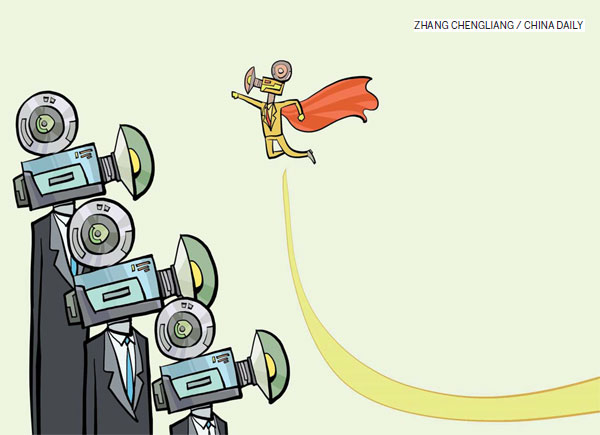Chinese films have a role for brands
Updated: 2016-04-01 08:29
By Mike Bastin(China Daily Europe)
|
|||||||||

Younger generations are increasingly attracted to their own stars and culture - and Western firms can take advantage
The Chinese film industry has arrived and taken its rightful place on the world stage - and is set to stay.This has far-reaching consequences for Chinese consumption across numerous industries.
In recent times, the Chinese film industry appears to have overtaken even Hollywood in its appeal and influence where Chinese younger generations are concerned.
As we move firmly into the all-important spring and summer seasons for so many products and services, it is perhaps the fashion and luxury industries where this influence can be seen most.
The entertainment industry, and film in particular, has always played a huge part in setting and changing fashion trends, styles and colors. But it is only fairly recently that Chinese films and film stars have reached further into the mindset of the Chinese public than their Hollywood counterparts.
This is a particularly important time of the year to look at this, with the "dump months" (January and February) now well and truly out of the way and the expected spike in film viewing already taking place.
European fashion brands must study the changing international film industry closely not only to gain invaluable insights into new fashion trends, but also to evaluate suitable product placement opportunities.

This is because it is not only Chinese films and film stars are increasingly influential globally. It has become apparent recently that much of the entire international film industry has now set its sights on China and is moving away from the time-honored heartlands of Western Europe and North America.
It was only last year, for the first time, that the size of the Chinese film market exceeded that US market. Furthermore, the trend is upward for the Chinese box office which has seen double-digit growth year after year for the past few years.
Proof of the arrival of Chinese films and the highest professional standards that now apply inside Chinese studios can be seen at the box office. Last year, two of the top five best-viewed Chinese film releases were produced and directed domestically.
Such is the growth of cinema in China that it has even outpaced the country's economic growth. By some estimates, ticket sales have grown by as much as seven or eight times more than GDP growth. In stark contrast, ticket sales in the United States continue to steadily decline.
The opportunity for even further, explosive growth in China is also apparent. A rough approximation puts the number of screens in China at around 28,000, in comparison with the US's 40,000, but by next year this 28,000 is widely predicted to rocket to around 53,000.
Clearly, international film producers and Western fashion brands cannot continue to ignore the Chinese film market.
Chinese consumers, especially those born after 1980, increasingly value the appearance of Chinese film stars. Moreover, it is also film content based on aspects of Chinese culture that many Chinese cinemagoers relate to closely.
At a time when sales of major Western fashion brands such as Louis Vuitton and Chanel continue to struggle across the Chinese mainland, this growth in the Chinese film industry could not be more apposite.
It is also a time of increased change and unpredictability in fashion trends across China, but the film industry may just provide a golden opportunity for shaping current and future fashion trends.
Effective product placement of fashion brands appearing in increasingly popular Chinese films should form a key part of any market penetration strategy across China.

Western fashion brands should also make great efforts at pairing their brands with attractive Chinese film stars whose influence now appears to exceed US film stars with younger generations.
Western fashion brands should also focus much more on the roles played by Chinese actors, as well as their apparel and accessories, such as color schemes, textiles and design. This should play a far more prominent part in their fashion trend forecasting process.
At a time when many of the most famous fashion and luxury brands are seeking growth via younger consumers, and the majority of Chinese luxury fashion consumers are under the age of 35, involvement in and an increased understanding of the Chinese film industry is an absolute must.
The international film industry should also consider this explosive growth in the Chinese film market positively. The Chinese film industry, despite its rapid rise, is keen to learn from the West and collaborate.
But any collaboration has to tease out the strengths and approach of the Chinese side. Attempts at some sort of straight replication of typical Western film industry methods will more than likely lead to failure.
The Chinese filmgoer, while still valuing Western influence, is highly likely to be attracted more to any Chinese creative and artistic input. Any domineering Western partner will surely stifle such input.
Finally, it is vital for Western fashion brands and Western film industry players to appreciate the opening up of opportunities across China. First-tier cities remain dominant economically, but second- and third-tier cities will receive more support now and become relatively much more attractive.
The author is a visiting professor at the University of International Business and Economics in Beijing and a senior lecturer at Southampton University. The views do not necessarily reflect those of China Daily.
Today's Top News
Inspectors to cover all of military
Britons embrace 'Super Thursday' elections
Campaign spreads Chinese cooking in the UK
Trump to aim all guns at Hillary Clinton
Labour set to take London after bitter campaign
Labour candidate favourite for London mayor
Fossil footprints bring dinosaurs to life
Buffett optimistic on China's economic transition
Hot Topics
Lunar probe , China growth forecasts, Emission rules get tougher, China seen through 'colored lens', International board,
Editor's Picks

|

|

|

|

|

|







